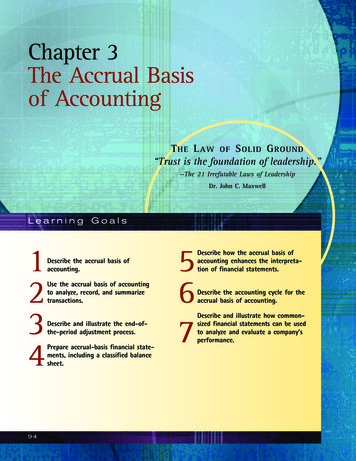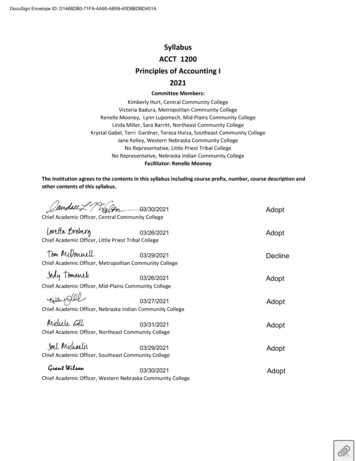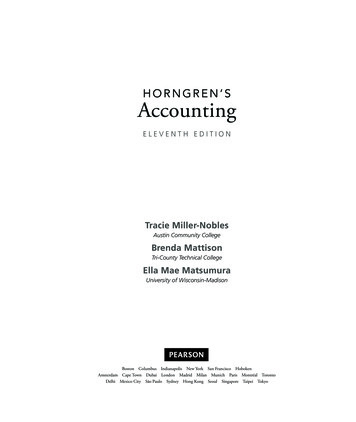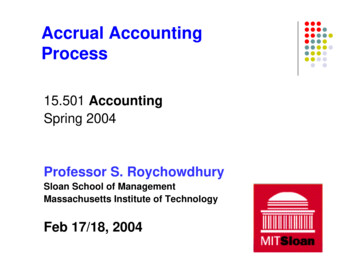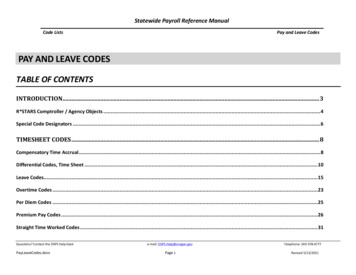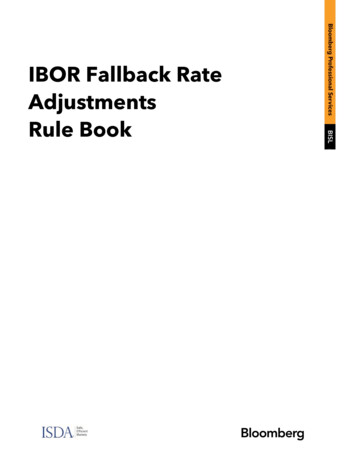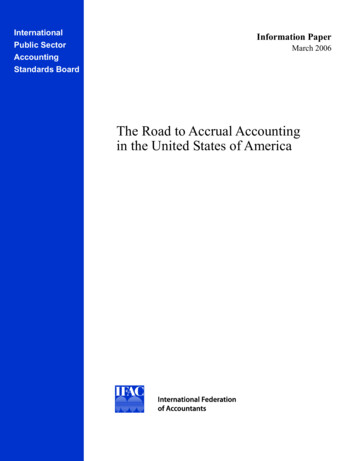
Transcription
InternationalPublic SectorAccountingInformation PaperMarch 2006Standards BoardThe Road to Accrual Accountingin the United States of America
This information paper was issued by the International Public Sector Accounting StandardsBoard (IPSASB), an independent standard-setting body within the International Federation ofAccountants (IFAC). The objective of the IPSASB is to serve the public interest by developinghigh quality accounting standards for use by public sector entities around the world in thepreparation of general purpose financial statements. This will enhance the quality andtransparency of public sector financial reporting and strengthen public confidence in publicsector financial management.This publication may be downloaded free-of-charge from the IFAC website: http://www.ifac.org.The approved text is published in the English language.The mission of IFAC is to serve the public interest, strengthen the worldwide accountancyprofession and contribute to the development of strong international economies by establishingand promoting adherence to high-quality professional standards, furthering the internationalconvergence of such standards and speaking out on public interest issues where the profession’sexpertise is most relevant.International Public Sector Accounting Standards BoardInternational Federation of Accountants545 Fifth Avenue, 14th FloorNew York, New York 10017 USACopyright March 2006 by the International Federation of Accountants (IFAC). All rightsreserved. Permission is granted to make copies of this work provided that such copies are for usein academic classrooms or for personal use and are not sold or disseminated and provided thateach copy bears the following credit line: “Copyright March 2006 by the InternationalFederation of Accountants. All rights reserved. Used with permission.” Otherwise, writtenpermission from IFAC is required to reproduce, store or transmit this document, except aspermitted by law. Contact Permissions@ifac.org.
ACKNOWLEDGEMENTThe International Public Sector Accounting Standards Board (IPSASB) of the InternationalFederation of Accountants (IFAC) is indebted to David R. Bean, Dean Michael Mead, KennethR. Schermann, and Roberta E. Reese of the Governmental Accounting Standards Board (GASB)for preparing this occasional paper.The IPSASB would also like to thank staff at the Financial Accounting Standards AdvisoryBoard (FASAB) and Robert Dacey, Chief Accountant at the United States GovernmentAccountability Office, for their input to the paper; and Robert Attmore, GASB Chairman, andRon Points, United States member, for their reviews and comments on drafts.The views expressed are those of the authors and not necessarily of the IPSASB, IFAC, or theGASB.The paper refers to a number of publications of the GASB and the FASAB. These publicationscan be accessed at www.gasb.org and www.fasab.org.David R. Bean is Director of Research and Technical Activities at the GASB and the TechnicalAdvisor to the USA Member on the IPSASB.Dean Michael Mead is a Project Manager at the GASB.Kenneth R. Schermann is the Senior Technical Advisor at the GASB.Roberta E. Reese is a Project Manager at the GASB.1
PREFACEAn increasing number of jurisdictions are moving to adopt the accrual basis of accounting forfinancial reporting by public sector entities. Some jurisdictions have already adopted the accrualbasis, others are in the process of migrating from the cash basis to the accrual basis and somecontinue to strengthen reporting under the cash basis or near cash basis as preparation for themigration at an appropriate time in the future.Adoption of the accrual basis of accounting will enhance the accountability and transparency ofthe financial statements of governments and government agencies and provide better informationfor planning and management purposes.The challenges for those moving to the accrual basis include both development andimplementation issues. They also include establishment of appropriate institutional arrangementsand mechanisms to promote, manage, and assist in the movement to the accrual basis. Differentenvironments and administrative structures will evoke different responses to these issues.This paper considers the experiences of the United States of America (USA) in its movement toaccrual accounting. It outlines the development of administrative arrangements for formalstandards setting over 70 years at the Local, State and Federal Government levels in the USA,and highlights key factors shaping the standards setting structure. It also provides a detailedoverview of the conversion to accrual accounting by state and local governments, the standardsissued by the GASB to lead and support that conversion, and identifies key milestones in theconversion process.2
THE ROAD TO ACCRUAL ACCOUNTING IN THE UNITED STATES OF AMERICATABLE OF CONTENTSPageCHAPTER 1 – THE ENVIRONMENT .4Governments in the United States.4Environmental Differences between the Public and Private Sectors in theUnited States .5Governmental Accounting Standards Setting in the United States – A Brief History .6State and Local Government Standards Setting.6Federal Government Standards Setting .7CHAPTER 2 – THE ROAD TO ACCRUAL-BASIS STANDARDSFOR STATE AND LOCAL GOVERNMENT .10Many Starts and Stops along the Way .10The Major Features of GASB Statement 34 .13CHAPTER 3 – IMPLEMENTATION ISSUES ASSOCIATED WITH THEADOPTION OF ACCRUAL ACCOUNTING IN STATE AND LOCALGOVERNMENT.27Capital Assets.27MD&A .30CHAPTER 4 – U.S. ACCRUAL STANDARDS IN AN INTERNATIONALCONTEXT.31CHAPTER 5 – THE AFTERMATH OF THE NEW REPORTING MODEL .34Lesson One: The Role That Publicity Plays .34Lesson Two: Education and Implementation Assistance Are Essential.35Lesson Three: Be Alert to the Potential for Standards Overload.37Conclusion .37APPENDIX A – FEDERAL FINANCIAL REPORTING.38APPENDIX B – STATEMENTS OF THE GOVERNMENTALACCOUNTING STANDARDS BOARD .55APPENDIX C – STATEMENTS OF THE FEDERAL ACCOUNTINGSTANDARDS ADVISORY BOARD.58APPENDIX D – GASB AND FASAB PROJECTS .60APPENDIX E – GLOSSARY .613
THE ROAD TO ACCRUAL ACCOUNTING IN THE UNITED STATES OF AMERICATHE ROAD TO ACCRUAL ACCOUNTING IN THE UNITED STATES OF AMERICAChapter 1—The EnvironmentGovernments in the United StatesTo gain a true appreciation for the 70-year road to accrual accounting for governments in theUnited States of America (U.S., or United States), it is helpful to understand U.S. governmentalstructure. All governments in the United States can trace their roots to the state level ofgovernment. Whether it was the creation of the U.S. government (federal government) in 1776by the 13 original colonies (which became states) or the sanctioning of the 87,576 units of stateand local government1 that have been created as a result of state statutes, the sovereignty of thestates has influenced not only the structure of governments, but also their accounting standards.The role of all forms and levels of government in establishing accounting standards in the U.S.and the movement to accrual accounting are the focus of this paper.Exhibit A provides some interesting statistics on how the 87,576 units of government in theUnited States are structured.Exhibit AUnited StatesUnits of Government2002 CensusType of GovernmentFederalStateLocal Governments:General ool districtsFire protectionWater supplyHousing and community developmentDrainage and flood controlSoil and water conservationSewerageCemeteriesLibrariesParks and recreationSewerage and water supply districtsOther multiple-function districtsOther special 7297,05887,576U.S. Department of Commerce, Bureau of the Census, 2002 Census of Governments.
THE ROAD TO ACCRUAL ACCOUNTING IN THE UNITED STATES OF AMERICAEnvironmental Differences between the Public and Private Sectors in the United StatesThe purpose for which governments were formed in the United States is different from thepurpose for which business enterprises are created. At its core, government’s role is to maintainor improve the well-being of citizens by providing public services and goods, such as publicsafety, public education, and public transportation, which the free market system often does notprovide adequately or equitably. Additionally, governments have the ability to create and enforcelaws that provide structure and order for the functioning of society, including providing thefoundation for the conduct of free-market business enterprise. At their core, business enterprisesin the private sector are formed to generate a return on investment and enhance the wealth oftheir owners.One difference in the financial relationship between U.S. citizens and their government, andbetween shareholders and their business enterprise, is the involuntary aspects of the former andvoluntary nature of the latter. U.S. governments are representational democracies. Becauseindividual citizens involuntarily provide resources in the form of taxes, they are entitled to holdgovernments to a high degree of accountability, which encompasses not only a demonstrationthat resources obtained were used in a manner consistent with the purpose for which they wereobtained, but also an assessment of whether the resources raised in the current period weresufficient to fund the cost of the services provided, or whether the funding of current-year costswas shifted to future periods.Taxation—the most significant involuntary resource for most governments in the UnitedStates—is a source of revenue that is not found in the private sector. The conceptual differencebetween tax revenue and sales revenue, the predominant source of business enterprise revenue, isthat tax revenues are not directly correlated to the services provided to the individual taxpayers,whereas sales represent a voluntary exchange of a product or service for cash or another asset ofsimilar value. The governments’ ability to tax its citizens leads to the conclusion thatgovernments effectively have ongoing existence and are not subject to directly observablemarket forces that affect business enterprises’ continued existence.Governments acquire most capital assets because of the asset’s capacity to provide services tothe citizenry, whereas business enterprises acquire capital assets with the objective of using themto generate future cash flows. This key difference, along with social policy obligations, has had aprofound affect on both U.S. and international accounting standards that apply to the publicsector.Finally, a government’s budget takes on a special significance. In the United States, manyconsider the budget to be the most important financial document that governments issue. Forbusiness enterprises, the budget represents an internal financial management plan. Forgovernment, the budget is an expression of public policy priorities and, in most cases, serves tolegally authorize the purposes for which public funds can be spent. Furthermore, in the U.S. formof representational democracy, citizens and their elected representatives have the ability to holdtheir governments accountable for complying with the requirements of the budget.5
THE ROAD TO ACCRUAL ACCOUNTING IN THE UNITED STATES OF AMERICAAll of these environmental differences have had a profound effect not only on how standards areset in the United States, but also on the accounting principles established by U.S. standardssetters.Governmental Accounting Standards Setting in the United States—A Brief HistoryState and Local Government Standards SettingFormal accounting standards setting for state and local governments in the United States beganin 1933 with the establishment of the National Committee on Municipal Accounting (NCMA).The original 10-member NCMA issued its first bulletin (standard) in January 1934. In 1948 theNCMA became the National Committee on Governmental Accounting (Committee), in part torecognize in name the important role that state governments play in regulating localgovernments. This role is one of the important environmental differences that set the UnitedStates apart from many governments around the world. Instead of accounting principles beingestablished or at least approved at the federal (national) government level, the power to setaccounting standards for state and local governments resides with the 50 individual states.Recognition of what effect 50 separate sets of accounting standards could have on the municipalfinancial market (over 30,000 local governments have at least one public debt issue outstanding,with the total being over 1.5 trillion)2 was one of the primary motivators in establishing arecognized government standards setter. The number of potential standards setters increasesgreatly when Native American tribes (which are also sovereign entities that choose to followstate and local government accounting standards) are taken into account.After the initial standards were developed, the Committee met on an ad hoc basis to keep thestandards current. Combined, the NCMA and the Committee issued 17 bulletins and a finalauthoritative update and codification of those standards in the form of the GovernmentalAccounting, Auditing, and Financial Reporting (GAAFR, or the blue book). The blue bookremains an important nonauthoritative source for government finance officers, with the latestedition being released in 2005. The GAAFR is now published by the Government FinanceOfficers Association of the United States and Canada (GFOA).In 1973, the National Council on Governmental Accounting (NCGA) was formed to reexaminethe financial reporting model. By establishing a regular meeting schedule, the 21-member NCGAmoved state and local government accounting standards setting from an ad hoc basis to astructured basis to address important issues of the day. During its 11 years of existence, theNCGA issued seven statements, 11 interpretations, and one concepts statement. For 51 years,through the lifetime of the NCMA, the Committee, and the NCGA, the GFOA played animportant role in public-sector standards by providing a corporate umbrella to the state and localgovernment standards-setting process.The creation of the current standards setter for state and local governments, the GovernmentalAccounting Standards Board, can be traced back in part to one standard and one ConceptsStatement issued by its sister organization, the Financial Accounting Standards Board (FASB).The FASB was established in 1973 with a clear mandate to issue standards applicable to the26Department of Commerce, Bureau of the Census, 2004.
THE ROAD TO ACCRUAL ACCOUNTING IN THE UNITED STATES OF AMERICAprivate sector. However, even with the existence of the NCGA, some questioned who hadstandard setting jurisdiction over state and local governments. The FASB stated in its StatementNo. 35, Accounting and Reporting by Defined Benefit Pension Plans, issued in 1980, that theprovisions apply to “. . . an ongoing plan that provides pension benefits for the employees of oneor more employers, including state and local governments. . . .” That standard was followed laterthat year by FASB Concepts Statement No. 4, Objectives of Financial Reporting by NonbusinessOrganizations, which noted, “the Board is aware of no persuasive evidence that the objectives inthis Statement are inappropriate for general purpose external financial reports of governmentalunits.” Many around the world agree with and adhere to this principle. However, there werethose in the United States who believed that there was persuasive evidence that both the pensionstandard and the objectives in the Concepts Statement were inappropriate for the public sector,and they set out to establish a new standards-setting body for state and local governments.After several years of negotiations, including reaching an arrangement on jurisdiction, the GASBwas formed in 1984. Like its sister organization the FASB, the GASB also was established underthe auspices of the Financial Accounting Foundation (FAF). The FAF has the same relationshipwith the FASB and the GASB. The FAF Trustees appoint GASB members, raise moneys for thesupport of the GASB, and provide oversight for the GASB. With the establishment of the GASB,the FAF Trustee membership was expanded in 1984 by three to 16 members to accommodatemembers with state and local government backgrounds.The GASB started with a five-member Board that consisted of a full-time chairman and fourpart-time members. Over the years, the Board has seen several structural changes, with the latestoccurring in 1997. At that time, the Board was expanded to seven members, with the chairmancontinuing to serve as the only full-time member. The six part-time members devoteapproximately one-third of their time to GASB activities. All of the Board members arecompensated for their services. The Board members are appointed based in part on theirbackgrounds (for example, preparers, auditors, financial statement user). However, asindependent individuals they are not representatives of any government or organization.The Board is supported by 18 technical and direct administrative staff (as of December 31,2005). The GASB is also supported by the Governmental Accounting Standards AdvisoryCouncil (GASAC). The GASAC is a 29-member body that provides advice and counsel to theGASB on issues ranging from the Board’s technical agenda to constituent communications. Todate, the GASB has issued 47 standards, six Interpretations, 12 Technical Bulletins, and threeConcepts Statements.The FAF provides administrative support for both the FASB and the GASB, includingpublication production, accounting, and human resources. The Foundation as a whole, includingthe FASB and the GASB, has a total complement of over 150 employees.Federal Government Standards SettingAt the federal government level, the responsibility for financial reporting requirements residedwith the General Accounting Office (GAO, now the Government Accountability Office), theUnited States Treasury, and the Office of Management and Budget until 1990. Over the years, all7
THE ROAD TO ACCRUAL ACCOUNTING IN THE UNITED STATES OF AMERICAthree entities issued guidance that addressed financial reporting issues. Most of this guidance wasconsistent, although there were cases of conflict.In 1990, the current U.S. national government standards setter, the Federal Accounting StandardsAdvisory Board (FASAB), was formed. It was established based on a memorandum ofunderstanding between the FASAB’s three sponsors—the Comptroller General of the UnitedStates (representing the GAO), the Secretary of the U.S. Treasury (Treasury), and the Director ofthe Office of Management and Budget (OMB). The FASAB was created concurrent with thepassage of the Chief Financial Officers Act, which, as amended, requires the federal government(including its component units) to issue annual, audited financial statements.The FASAB parallels the FASB and the GASB in many respects. One key difference is thatbecause FASAB involves both the executive and legislative branches of the federal governmentas well as the private sector, compliance with the U.S. Constitution requires that theadministratively established FASAB have the legal status of an advisory board. Because theFASAB’s authority stems from those of the sponsors that established it, FASAB submits anyconcepts statements and standards it develops to its sponsors for review. The concept statementor standard is then issued, unless OMB or GAO objects within 90 days. To date, all conceptsstatements and standards developed by FASAB have been issued.The entire 10-member FASAB serves on a part-time basis and is funded by appropriations fromthe three sponsors and the Congressional Budget Office. To enhance the FASAB’s independence,a majority of members are not federal government employees. The FASAB is supported by aneight-member technical staff (as of December 31, 2005), supplemented by contractors from timeto time.During its existence, two former GASB members have served on the FASAB; one former FASBmember currently serves on the FASAB as its chair and one former FASB member recentlyretired as a FASAB member. In 2006, a former GASB chair was named to the FASAB as acurrent member and successor chair (2007). To date, the FASAB has issued 30 Statements, sixInterpretations, and four Concepts Statements.As the chart in Exhibit B on the following page illustrates, each of the standards setters hasclearly defined jurisdictional lines of authority, and all three are now recognized by the AmericanInstitute of Certified Public Accountants (AICPA)3——as bodies that establish generallyaccepted accounting principles in the United States. Within the federal domain, a small numberof entities, such as the U.S. Postal Service and the Tennessee Valley Authority, follow standardsestablished by the FASB for their individual entity financial statements.Even though the three Boards are independent of each other, each Board considers the standards,concepts, and progress on current projects of the others as part of their individual standard settingprocess.38The AICPA sets generally accepted auditing standards for all entities in the United States with the exception ofSecurities and Exchange Commission–registered public companies.
THE ROAD TO ACCRUAL ACCOUNTING IN THE UNITED STATES OF AMERICAThe primary focus of the remainder of this paper is on the conversion to accrual accounting bystate and local governments based on the standards issued by the GASB. However, Appendix Aprovides an overview of the federal reporting model.Standard Setting Structure in the profitentitiesState and localgovernmententities (includingnative americantribes)OMBExhibit ldentities9
THE ROAD TO ACCRUAL ACCOUNTING IN THE UNITED STATES OF AMERICAChapter 2—The Road to Accrual-Basis Standards for State And Local GovernmentWhen the last chairman of the National Council on Governmental Accounting formallytransferred the responsibilities of state and local government standards setting by turning thegavel over to the first chairman of the GASB in June 1984, the transfer included a list ofsuggestions for projects that the NCGA had yet to complete. Two of the projects, themeasurement focus and basis of accounting (MFBA) project and the financial reporting modelproject, became the basis for what eventually would become the new accrual-based financialreporting model for state and local governments in the United States. When the GASB wasestablished, some predicted that the MFBA and reporting model projects would take no morethan two years to complete. In the end, however, it was a 15-year endeavor.For over 70 years, financial reporting for state and local governments in the United States wasbased primarily on a current financial resource flows measurement focus4 and modifiedaccrual basis of accounting (often referred to as the modified cash basis in other parts of theworld), within a fund accounting model. Under this basis of accounting, revenues are recognizedwhen they are available to liquidate current liabilities (normally defined by an availabilityperiod) and expenditures are recognized when they are normally liquidated with expendableavailable financial resources (normal is defined in terms of what occurs for most governments,so that a government cannot delay the recognition of a normal operating expenditure just becauseit does not have resources available as of the balance sheet date). This MFBA/fund accountingmodel provides an important link between budgeting and external financial reporting. Most U.S.government budgets are adopted using the cash basis of accounting, the modified accrual basis ofaccounting, or a budgetary basis that is somewhere between the two.The financial position of the government was reported in a balance sheet that presented allfinancial resource assets and current financial resource liabilities by fund type, with separateaccount groups that presented capital assets and long-term liabilities. The GASB recognized thatmore complete reporting was necessary to meet the objectives set forth in GASB ConceptsStatement No. 1, Objectives of Financial Reporting. Those objectives are identified in Chapter 5of this paper.Many Starts and Stops along the WayThe reexamination of the state and local governmental financial reporting model was added tothe GASB’s original technical agenda in 1984. This section of the paper is intended to showsome of the difficulties that were faced, at least from the state and local government perspective,in moving to a new accrual-based financial reporting model. It was a 15-year endeavor thathopefully other nations in their transition to accrual accounting will not encounter. Despite thedownsides associated with the length of the project, the long process ultimately did lead togreater acceptance of the final standards. Everyone had “his day in court.” In other words,throughout this journey—due process documents, public hearings, focus group meetings, taskforce meetings, and a variety of other venues—all of the GASB’s constituents had an opportunityfor their views to be heard by the GASB.410Terms defined in the Glossary (Appendix D) are printed in boldface type when they first appear.
THE ROAD TO ACCRUAL ACCOUNTING IN THE UNITED STATES OF AMERICAThe project began with a user needs study that resulted in the publication of the GASB ResearchReport, The Needs of Users of Governmental Financial Reports, by David B. Jones and others in1985. This report was followed by Concepts Statement 1. Before turning almost its completeattention to the financial reporting model, the GASB tackled the financial reporting entity issuewith the issuance in 1990 of GASB Statement No. 14, The Financial Reporting Entity. Thisstandard was developed based on an accountability principles approach which in most cases isbroader than a control-based principles approach. Even with this approach, one level ofgovernment (for example, local governments) generally is not included in the reporting entity ofanother level government (for example, a state government); therefore, there is no centralgovernment reporting entity in the United States.As work was being done on the financial reporting model, the GASB also was advancing aseparate project on MFBA issues. This project began with a discussion memorandum (DM) in1985, Measurement Focus and Basis of Accounting—Governmental Funds. A DM is a neutralstaff document that was used in this case to solicit views on alternatives for fund reporting,ranging from the current financial resources measurement focus and modified accrual basis ofaccounting (the model that was in place at the time for governmental funds) to the economicresource flows measurement focus and accrual basis of accounting (the model in place at thetime of proprietary funds—business-type activities). With feedback received on the DM, theGASB embarked on developing an exposure draft (ED). An ED, as used by the GASB, is aproposed Statement of the Board. Although the proposed provisions of an ED are subject tochange based on due process feedback, it is not intended to be used as a document to presentproposals that the Board would abandon at the slightest hint of criticism. The first ED on thisproject, issued in 1987, proposed a total financial resources measurement focus and accrualbasis of accounting for the governmental funds. (Business-type activities were being addressedin another project at that time.) However, the proposed model was not well received by theGASB’s constituency. A second ED was issued in 1989. That ED continued with the proposal ofa total financial resources measurement focus and accrual basis of accounting, but eliminatedsome of the more controversial issues by limiting the scope of application to just thegovernmental fund operating statements. This effort resulted in the issuance in June 1990 ofGASB Statement No. 11, Measurement Focus and Basis of Accounting—Governmental FundOperating Statements. Statement 11 was
THE ROAD TO ACCRUAL ACCOUNTING IN THE UNITED STATES OF AMERICA 6 All of these environmental differences have had a profound effect not only on how standards are set in the United States, but also on the accounting principles established by U.S. standards setters. Governmental Accounting Standards Setting in the United States—A Brief History

